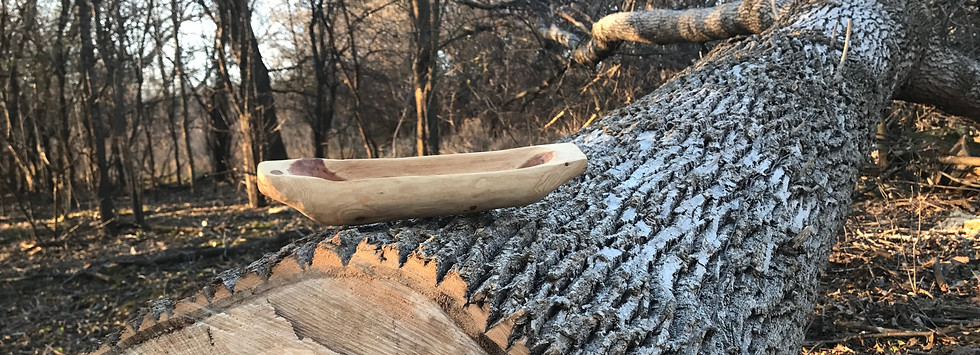
FIRE, WATER, & A GREAT BIG LOG
Since 2021, we have been on a quest to experimentally create a fire-wrought dugout canoe using ancient methods and tools. Each time, we try new methods and ideas.
Whether you come to get your hands dirty or you prefer to simply observe and learn, we hope you will join us in experimenting with the ancient art of turning a tree into a watercraft. Adults and teens (accompanied by a responsible adult) are invited to participate. Come for the whole workshop or drop in when you can.

Dugout Canoe Diary
Rediscovering a Lost Skill
With the arrival of Europeans in the Americas, iron tools drastically changed how dugout canoes were made. By the era of the Agency House (early 1830s), the ancient way of making canoes out of logs was a distant memory. The adze and hatchet marks on canoes made from that time forward contrast with pre-Columbian specimens which exhibit charring and few, if any identifiable, tool marks. How did Indigenous peoples make canoes with the tool kits we find through archaeology? The quest for the answer to how canoes were made with fire rather than iron tools has led researchers to the archives in search of the narratives of the earliest explorers, and then out to the woods to test theories using fire and stone, bone, and shell tools which are discovered through archaeology. Our project is indebted to earlier researchers, but is an ongoing process of experimentation in which we are excited to be involved.

Project Preparation: Feb/March '21
Dugout canoe construction is a massive undertaking. Literally. The tree needs to big enough to sit in. As can be imagined, that takes an awfully big log. The trunk must also be straight and have few low branches since every branch will leave a knot which could leak. Our log is from an ash tree and is about 12.5 feet long and 22 inches in diameter which is on the small end of the spectrum, but is similar in size to known examples. This tree was killed by beetles and has been standing dead for over a year. It sounds a little hollow, which could be good (or not), but we won't know until the top is split off. Wood species used in dugouts vary by region, but the use of hardwoods is well documented in the upper Midwest.


May 8: Preparation Continued
After being moved into location, the top third of the log was cut off (thanks to the assistance of site volunteer Fred Galley). Due to the presence of some stubborn knots, it was determined that using modern technology rather than splitting the top off using wedges would be the safest route to preparing the log for the start of the project. Traditional splitting methods, however, will be the object of experimentation (on supplementary pieces of wood) during our inaugural burn.


May 28: Getting Started
We had a successful first burn. After discussing the history of dugout canoes and how research has led to hypotheses about their ancient methods of construction, the log's bark was peeled and we experimented with splitting techniques. The burn was started with historic flint and steel methods. Participants constructed swabs from sticks and strips of cloth which were used to keep the fire from burning to the edges of the log. The first burn created a good basis from which to continue our work. During this first burn, an experiment was set up in which appx. one-third of the burning surface was pre-treated with linseed oil to replicate an early explorer's description of coating the surface with a combustible liquid (pine tar). Initial results show no perceivable difference, but measurements will be taken after the char has been chipped away. The last Friday in June, we will be experimenting with various ancient methods of char chipping as well as trying out the roving-fire method which allows burning and scraping to be done simultaneously. We'll also be trying out our char cloth which we made in the coals of the fire. Unfortunately our bark char material combusted in the process (photo of flame erupting from tin at right)

_edited.jpg)
June 25: Char Chipping and Burn
#2 with Roving Fire
Our second burn involved a couple new experiments. First, the charred layer from the first burn needed to be removed so that the evening's burn would be eating into fresh wood. An array of experimental tools based on early descriptions and what is found through archaeology were recreated including a sandstone adze, a sandstone axe, a granite scraper, two flint adzes, and a variety of clamshell scrapers.
What was immediately apparent was the fact that "char chipping" might not be the most accurate word to describe the process. What archaeologists call stone adzes in this application are not used as adzes at all. Rather, a scraping technique with all the experimental tools was much more efficient. Clamshells chipped while in use, as did the flint adzes, but the stone tools remained relatively unaffected, particularly the granite example. The consideration that shells are readily replaceable with far less energy than making stone tools (which take hours of labor intensive grinding, or knapping to produce) correlates with early explorers' descriptions of the process which indicate a reliance on shell tools.
The other experiment of the evening involved moving the fire from one side of the log to the other, allowing char scraping to occur in real time. This offered the chance to scrape off multiple burn layers in one night's work. Last month's char layer was approximately 0.25" to 0.5" in depth. The layers produced by two scrapings tonight totaled approximately the same depth. Thus, "roving" the fire from side to side is most effective if repeated multiple (3+) times in a day's work. By way of update, last week's linseed oil treatment appears to have made little difference when compared with the char layer of untreated areas.




July 30: Third Burn and Historic Fire Starting Methods
Our third regularly scheduled burn (technically our fourth due to an extra burn in mid-July) has resulted in continued progress. The depression in the log is now approaching 1.5" in some areas.
Aside from the flint and steel which has been used for every burn to date, this month's burn featured additional fire starting options including a bow drill and pump drill. Both were theoretically effective, and the bow drill successfully ignited tinder without the use of char cloth. It is easy to see how flint and steel technology spread as the "easy" way to start a fire.
We're still a ways from completion, but the canoe is progressing.


August 27: Shaping Bow and Stern
Our August 27 burn marks the appx. 10th burn (six burns were accomplished during our Enduring Skills Weekend). While progress was at times hard to see early in the project, the interior depression has now deepened to just under 3," with many of the stubborn knots beginning to give way.
Only one burn was completed this time, but two additional fires were lit adjacent to one end of the canoe to begin shaping the outer hull. The canoe log is sitting above the ground on cross-pieces. During our enduring skills weekend, a fire was lit directly underneath the end of the log. This burn produced a good upward bevel on the bottom of the log, but left the side corners of the log intact. To burn these into a rounded shape, two fires were lit atop stump platforms on either side of the log's end. The resulting charring appears to have begun to accomplish the desired effect.
Another new experiment with this burn was the introduction of clay to prevent burn-through on the sides. While we had previously used swabs to wet down the sides, it has been difficult to keep the sides from charring as the fire burns deeper into the log. Thanks to Clare P., who has volunteered on this project from the beginning, we were able to acquire some clay to pack onto the upper edges of the canoe in place of swabbing. Other dugout experiments have indicated the usefulness of this material, and our burn confirmed this. Clay was also used to pack a small cavity in the end of the log. This hollow was opened by the mid-August exterior burn, and was packed to prevent further charring, while allowing the wood around it to burn toward the desired shape.
A final item of note from the night is that a good scraping completed by a volunteer at last night's burn (thank you!) resulted in the first visible tool marks in our canoe. While we had previously been using primarily our ground-stone adze to scrape charred material, our reproduction flint "Dalton" style adze became the night's tool of choice. This harder, sharper tool resulted in substantial scratch marks in the wood beneath the char layer (see photograph). While these will be gone with the next burn, these may be considered the main type of tool marks one would see with a solely burned and scraped canoe.


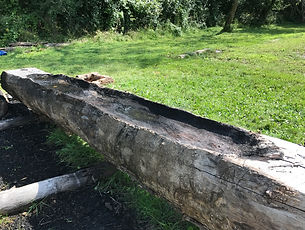
_JPG.jpg)
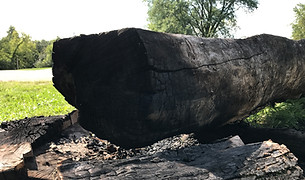

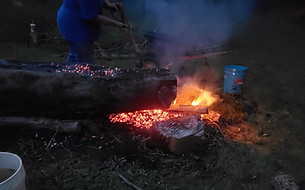

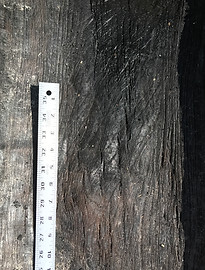
September 24: Final Scheduled Burn for 2021
The final scheduled burns of the season took place this Friday and Saturday in conjunction with HIAH's Scouts Camping and Cultures Weekend. Similar techniques as described previously were employed, with progress nearing the 3.5 inch mark. Friday night's storm front whipped up a pretty toasty fire which, produced a healthy char layer. We're looking forward to continuing the project in the coming year.
Additional burns this fall and next season are in the works. Completion at 2022's Enduring Skills workshop is the new goal. We're planning to take our time and learn along the way!

.jpg)

.jpg)
October 29: Extra 'pop-up' burn
The weather was cooler and damp this evening. We experimented with a little sand in the clay that we spread on the edges of the canoe so that it is more pliable and does not crack as much. We tossed around the idea that as we go deeper, in addition to the clay barrier, we may find a need to return to the use of our large swabs to keep the inside edges from burning.

June 10, 2022: Back at it
We're at it again with the first burn of 2022. The evening allowed for a burn on the interior of the canoe, as well as fires on either end. The firewood of choice this time was black locust which seemed to burn a bit more manageably and remain hot longer than the honeysuckle of last year. Using dense, hot-burning hardwood like black locust seems to be key. The fires used to shape each end made some good progress. On the west end of the canoe, we used an axe to chop far enough into the side to get past an angled chainsaw cut in the end and then began to burn it toward its external final shape.
.jpg)
.jpg)
.jpg)
June 17: Second Burn of 2022
Our second burn of the year offered a chance to test a new burning method. A visitor touring the museum had mentioned seeing a dugout canoe being made for an educational site by Wampanoag Native Americans on the East Coast. Low and behold, the internet allowed us to learn more about this project. One of the techniques the Wampanoag use is to burn continually, using stone tools and wooden poles to rearrange the coals and chip away the char while the fire is still burning. This way they are able to burn and scrape simultaneously, offering a way to continually expose new wood to the coals. For our second burn of the year, we decided to give this a try. We'll need to do it again to confirm, but this method of burning and scraping simultaneously seems to have made some significant headway! On other fronts, the exterior is coming along and beginning to look more like a canoe.

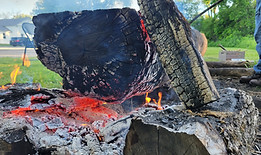


June 24: Third Burn of 2022
The burns continue. Our June 24 burn saw a continuation of the last week's scrape while burning method, but done over a longer period of time (from 4:30pm to 8pm). Progress seems to have continued as last week. The fire is now sitting more within the canoe rather than on top, requiring more vigilance to protect the sides from burning through. We are now using larger diameter logs as firewood in hopes that the cumulative prolonged heat as they burn will outperform the more volatile small brush. The outside of the canoe is also continuing to take shape. This external burning process progresses at a significantly faster rate than the interior burns since the fire can lick up the canoe, more quickly charring the wood.
.jpg)
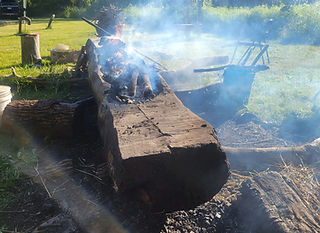.jpg)
.jpg)
July 8: Fourth Burn of 2022
Progress continues, slowly but surely. While no new methods were introduced with tonight's interior burn, the process of scraping while burning and building a hotter, quieter fire using larger pieces of hardwood (black locust) continues to make progress. It seems that the most charring may be accomplished once the fire has burned down to a hot bed of coals. The coals at this stage can also be more easily moved around while scraping.




Sept. 24: Fifth Burn of 2022
After a lengthy interim, we were able to hold a burn during our Scouts BSA Historic Trails weekend. With this burn, we focused entirely on shaping one exterior end of the canoe which we had begun burning earlier this summer. The goal is to burn the bow to a rounded, yet upturned shape as is seen in early canoes. After 3-4 hours of burning, the end is now taking some serious shape. This exterior work is much quicker than interior burns, but also resulted in (or perhaps just widened existing) cracks which will need to be sealed.
.jpg)



July 29, 2023: First Burn of 2023 Season
During our July 29-30 Enduring Skills Weekend, a roughly 5 hour burn was undertaken during which the fire remained lit and char scraping was accomplished with hardwood poles. The canoe's interior is visually looking deeper, and some high spots which were present last year have now leveled out. The cumulative effect of long burns seems to maximize efficiency during the process.
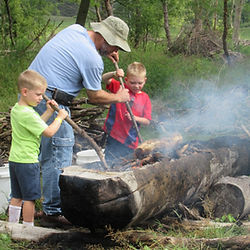.jpg)

September 8-9, 2023: Oxygen in the Triangle of Fire
On Friday and Saturday evening, two 3-4 hour burns were held, focusing again solely on the interior of the canoe. A new experiment was attempted: artificially adding air to the burn. The historic precedent for this venture comes from an early illustration in which the Indigenous canoe makers are seen blowing air on the fire with handheld fans. One struggle with canoe burning is the fact that heat rises. The canoe, itself, rarely visibly flames. Oxygen is a limiting component in the "triangle of fire" (heat, oxygen, and fuel). Relatively little oxygen can penetrate the coals/ash and reach the wood's surface. During these burns, we found that bathing the surface of the log with oxygen from a small bellows dramatically increased the charring effect, even causing the log's surface to ignite and combust. The results were surprising. One area of sustained blowing (in combination with scraping) ended up being nearly an inch deeper than the adjacent area which wasn't blown.





September 22, 2023: Last Scheduled Burn of the Year
This burn saw a continuation of the last burn's experimentation. The combination of blowing air on the fire with a bellows and arrangement of coals/fresh fuel offers a surprising amount of control over where charring takes place. One thing which sticks out is that the most effective charring happens where the ash has been blown away and where fresh wood is laid across a scattering of live coals.


Related Stories of Interest
Wisconsin Dugout Canoe Survey Project
The Historic Indian Agency House has in its collection an 1880s Ho-Chunk dugout canoe which on May 2, 2023, was digitally 3D scanned by UW professor Sissel Schroeder and WHS maritime archaeologist Tamara Thomsen for inclusion in the Wisconsin Dugout Canoe Survey Project (YouTube presentation here). The survey was launched in 2018, and has currently tracked down more than fifty dugout canoes around the state which are being documented and studied to better understand their history, design, and use.
Ancient Dugout Canoes Found in Lake Mendota
Thomsen (above) is also the diver who discovered and helped recover two ancient Indigenous dugout canoes on the bottom of Lake Mendota in Teejop (Four Lakes, Madison).

Wampanoag Fire-Wrought Dugout Canoe (Mishoon) Video
We recommend watching a fantastic YouTube video produced by Darius Coombs from the Mashpee Wampanoag Tribe for the Nantucket Historical Association. He demonstrates the process of constructing a fire-wrought dugout canoe, called a Mishoon.
Article on Efforts to Experimentally Reproduce Ancient Technologies
There is also an interesting article by Mike Volmar about fire-wrought dugout canoes and experimental efforts undertaken to reproduce ancient technologies.
